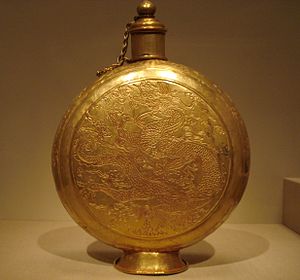 Global Information
Global InformationEconomic history of China before 1912 information

The economic history of China covers thousands of years and the region has undergone alternating cycles of prosperity and decline. China, for the last two millennia, was one of the world's largest and most advanced economies.[1][2][3] Economic historians usually divide China's history into three periods: the pre-imperial era before the rise of the Qin; the early imperial era from the Qin to the rise of the Song (221 BCE to 960 CE); and the late imperial era, from the Song to the fall of the Qing.
Neolithic agriculture had developed in China by roughly 8,000 BCE. Stratified Bronze Age cultures, such as Erlitou, emerged by the third millennium BCE. Under the Shang (16th–11th centuries BCE) and Western Zhou (11th–8th centuries BCE), a dependent[clarification needed] labor force worked in large-scale foundries and workshops to produce bronzes and silk for the elite. The agricultural surpluses produced by the manorial economy supported these early handicraft industries as well as urban centers and considerable armies. This system began to disintegrate after the collapse of the Western Zhou in 771 BCE, leaving China fragmented during the Spring and Autumn (8th–5th centuries BCE) and Warring States eras (5th–3rd centuries BCE).
As the feudal system collapsed, most legislative power transferred from the nobility to local kings. Increased trade during the Warring States period produced a stronger merchant class. The new kings established an elaborate bureaucracy, using it to wage wars, build large temples, and enact public-works projects. This meritocratic system rewarded talent over birthright. Greater use of iron tools from 500 BC revolutionized agriculture and led to a large population increase during this period. In 221 BCE, the king of the Qin declared himself the First Emperor, uniting China into a single empire, its various state walls into the Great Wall, and its various peoples and traditions into a single system of government.[4] Although their initial implementation led to its overthrow in 206 BCE, the Qin's institutions survived. During the Han dynasty (206 BC–220 AD), China became a strong, unified, and centralized empire of self-sufficient farmers and artisans, with limited local autonomy.
The Song period (960–1279 AD/CE) brought additional economic reforms. Paper money, the compass, and other technological advances facilitated communication on a large scale and the widespread circulation of books. The state's control of the economy diminished, allowing private merchants to prosper and a large increase in investment and profit. Despite disruptions during the Mongol conquest of 1279, the Black Plague in the 14th century, and the large-scale rebellions that followed it, China's population was buoyed by the Columbian Exchange and increased greatly under the Ming (1368–1644 AD/CE). The economy was remonetised by Japanese and South American silver brought through foreign trade, despite generally isolationist policies. The relative economic status of Europe and China during most of the Qing (1644–1912 AD/CE) remains a matter of debate,[n 1] but a Great Divergence was apparent in the 19th century,[7] pushed by the Industrial and Technological Revolutions.[8]
- ^ India and the Knowledge Economy: Leveraging Strengths and Opportunities. World Bank. 2005-01-01. p. 131. ISBN 9780821362082.
- ^ Dahlman, Carl J; Aubert, Jean-Eric. China and the Knowledge Economy: Seizing the 21st Century. WBI Development Studies. World Bank publications. Accessed January 30, 2008.
- ^ Angus Maddison. Chinese Economic Performance in the Long Run Archived 2014-10-15 at the Wayback Machine. Development Centre Studies. Accessed 2007. p.29 See the "Table 1.3. Levels of Chinese and European GDP Per Capita, 1–1700 AD" in page 29, Chinese GDP Per Capita was 450 and European GDP Per Capital was 422 in 960AD. Chinese GDP Per Capita was 600 while European was 576. During this time, Chinese per capita income rose by about a third.
- ^ Cite error: The named reference
Twitchett pg 54was invoked but never defined (see the help page). - ^ Shiue, Carol H.; et al., ?, NBER, archived from the original on 2006-05-28, retrieved 2014-12-20.
- ^ Maddison, Angus (2006), The World Economy. A Millennial Perspective, Historical Statistics, Vol. II, vol. I, OECD, p. 629, ISBN 978-92-64-02261-4.
- ^ Landes, David S. (1998), The Wealth and Poverty of Nations: Why Some Are So Rich and Some So Poor, New York: W.W. Norton & Co., pp. 29–44, ISBN 978-0-393-04017-3.
- ^ Cite error: The named reference
industrial2001was invoked but never defined (see the help page).
Cite error: There are <ref group=n> tags on this page, but the references will not show without a {{reflist|group=n}} template (see the help page).